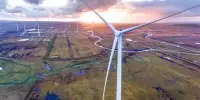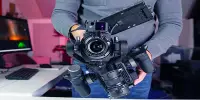Björn Ulvaeus, one of the band’s members, expressed their goal for fans to “feel that they’ve gone through something that they’ve never seen before” before the opening of “ABBA Voyage,” the London concert featuring 3D digital avatars of the legendary Swedish group.
Much of the response from domestic and foreign critics, fans, and business experts has been effusive since its May 27 launch.
“Other than the team involved, no one really knew how they would integrate an avatar-based performance,” Sarah Cox, director of live event technical consultancy Neutral Human, told CNBC. “That blew me away as someone working on real-time graphics. My jaw hit the floor. You look around and people are really buying into the idea that ABBA are there.”
Demand has been strong the show’s run has been extended to November 2023 and could well go beyond that.
And the team has confirmed it aims to take the show around the world.
“Our ambition is to do another ABBA Voyage, let’s say in North America, Australasia, we could do another one in Europe. We can duplicate the arena and the show,” producer Svana Gisla told a U.K. government committee session in November.
It also expects other shows to begin following the same model.
“The tech itself isn’t new but the way in which we’ve used it and scale and barriers we’ve broken down are new. I’m sure others will follow and are planning to follow,” Gisla said.
That could “absolutely” be the case somewhere like Las Vegas, where some shows run round the clock with rotating crews, she added.
“We have live musicians, so we keep our band and do seven shows over five days a week. But you could roll round the clock. Vegas will quickly adopt this style of entertainment and do Elvis or the Beatles.”
Money, money, money
The ABBA Arena, the venue for Voyage, was constructed especially for the show on a site in Stratford, east London. It has a seating capacity of 3,000 and features a standing pit, tiered seating along three sides without a view restriction, more expensive private “dance booths,” space for the large amount of equipment mounted in the roof, and what the show’s creators, White Void, claim is the largest permanent kinetic lighting installation in the world.
It was also designed for flexibility. Without breaking ground, it was built on a platform that was one meter above the ground. It could be taken apart and moved, or it could stay put and hold future performances.
It won’t be simple to replicate Voyage’s methodology, which involves four digitally recreated band members playing both old and new songs for 90 minutes while interacting with one another and chatting to the crowd in between songs.
The production took five years to complete and had a £141 million ($174.9 million) budget from international investors. According to Gisla, it requires approximately 3 million visitors to make a profit, and the typical ticket costs £75.
The ABBA members performed in motion capture suits for five weeks after deciding on their set list and other creative choices. Then, for the following two years, hundreds of visual effects artists worked on the program, under the direction of the London office of Industrial Light & Magic, a George Lucas-founded provider of visual effects.
Audiences were wowed by a Tupac Shakur performance at Coachella ten years ago that appeared to be a hologram; the artist’s likeness was digitally recreated without the use of old video, hinting at the potential for alternative reality in live performances.
The visual effects team projected a 2D image onto an angled piece of glass, which was then projected onto a Mylar screen, generating a 3D illusion, although not adhering to the technical definition of a hologram, which uses laser beams to produce an object with depth. Shakur then “performed” two songs with Dr. Dre and Snoop Dogg, 16 years after his death.
The Voyage crew is coy about the specifics of how their performance operates but has previously stated that it is not a laser-based hologram either. With standard concert screens showing close-ups and various angles on either side, the 65 million pixel screens create the illusion that the band is performing life-size on stage in 3D in real time.
Gisla claimed that in order to render the images without lag, its servers are being stressed to the “absolute extreme,” causing certain transitions to shake. She also noted that there should be improvements because the side screens, which are 10 meters high, are “very unforgiving” in terms of detail.
But, she added, with real-time render speeds becoming quicker, “Benny and Bjorn could be sitting in a chair at home connected to their avatar, updating them to talk about last night’s football result to the audience. That will come.”
Next steps
Although most companies cannot afford the processing and motion capture technology used by Voyage, consultant Sarah Cox said she feels it is a “brand-new format that will be duplicated time and time again,” especially in a city like Las Vegas.
“An immersive venue could host multiple shows. And then the cost comes down, because you have the technology stack, the venue, and all the money goes into creating the avatar and virtual experience and tweaking the programing.”
Many people will continue to be dubious about jobs based on digital avatars, especially if they are apprehensive of the wider trend toward virtual experiences based in the metaverse.
Bjorn Ulvaeus himself previously told CNBC he has concerns about the misuse of the technology to create nefarious “deep fakes” which will be “indistinguishable from the real thing going forward.”
There is also the question of finding suitable artists for shows. As a band with a substantial back catalog of classics, a multigenerational global fanbase, and a full lineup of members who are on board with the show despite not touring together in 40 years, ABBA is a unique offer.
“Posthumously you can put artists back on stage, ethically you may or may not have a view on that,” said Gisla. “Having ABBA partake in this is I can say this is an ABBA concert. ABBA made the decisions, chose what to wear, chose their set list, ABBA made this show.”
For an artist like Elvis with an extensive visual and audio archive you could create an accurate replica, but without the input that makes this show feel so tangible, she said.
For Cox, live shows that provide a “shared experience” like ABBA Voyage hold a greater appeal than headset-based virtual experiences, though there will certainly be more of those available in future.
And both AR and VR are spreading in the worlds of gaming, events, sports, theater and beyond.
In one attempt with a digital avatar, musician Travis Scott debuted a song in Fortnite in 2020, his avatar hovering over players who were still navigating the game’s virtual world. It got a reported 45.8 million viewers across five shows. Lil Nas X performed the same year in the game Roblox.
Jo Twist, chief executive of trade body UK Interactive Entertainment, said she was noticing growing opportunities in the intersections between games, music and entertainment experiences.
“While these kind of experiences have mostly been the preserve of the biggest artists so far, we believe that growth in both the number of people who play, and online game worlds that enable user generated content, could open games up to all kinds of performers, allowing them to successfully tap into its enormous player base to raise their profile.” she said.
Giulia De Paoli, founder and general manager of show design and AR studio Ombra, has worked on projects bringing “extended reality” spanning AR and VR to live sports.
“AR has permitted us to create a full show for broadcast events that would be impossible with traditional projection and LED setups, like creating huge 10-meter flying numbers and flames around the arena,” she said.
“We see this developing into a full experience for people to watch live and, as the word says, augmenting the reality around us, gamifying, interacting and seeing impossible things happen.”















